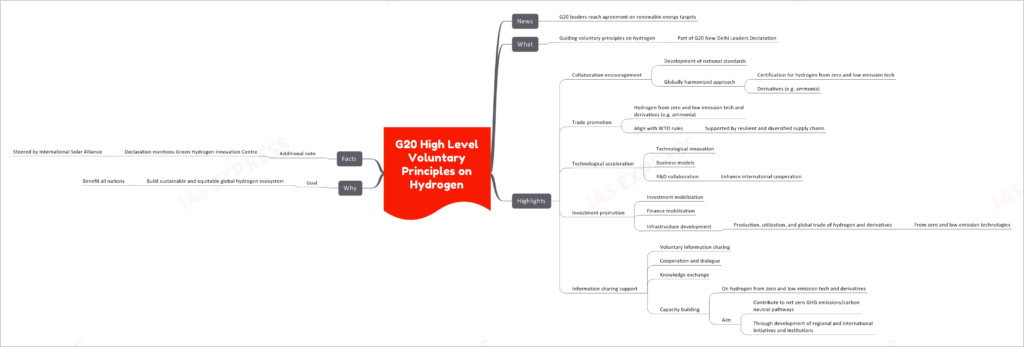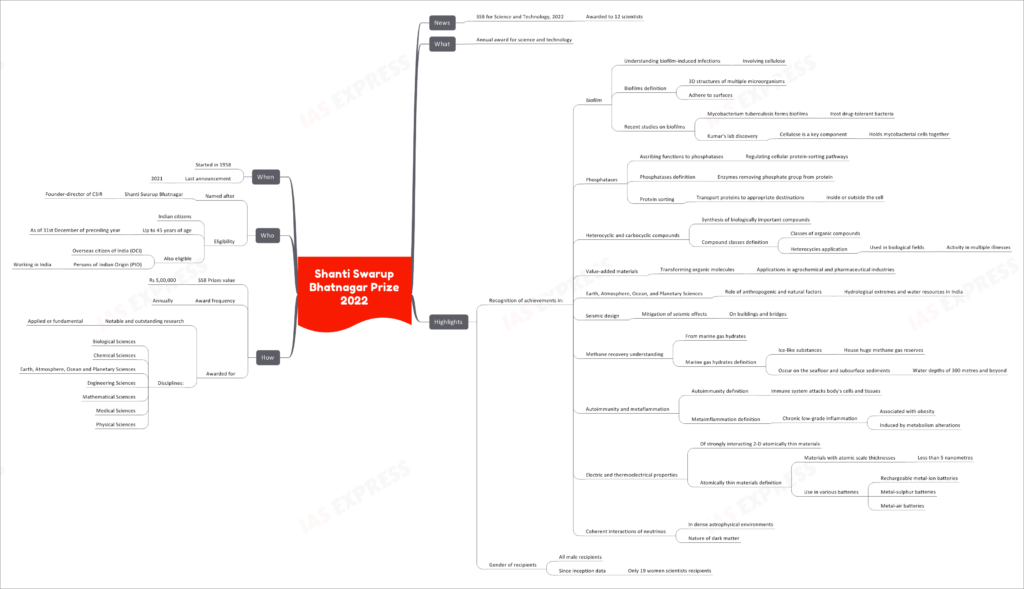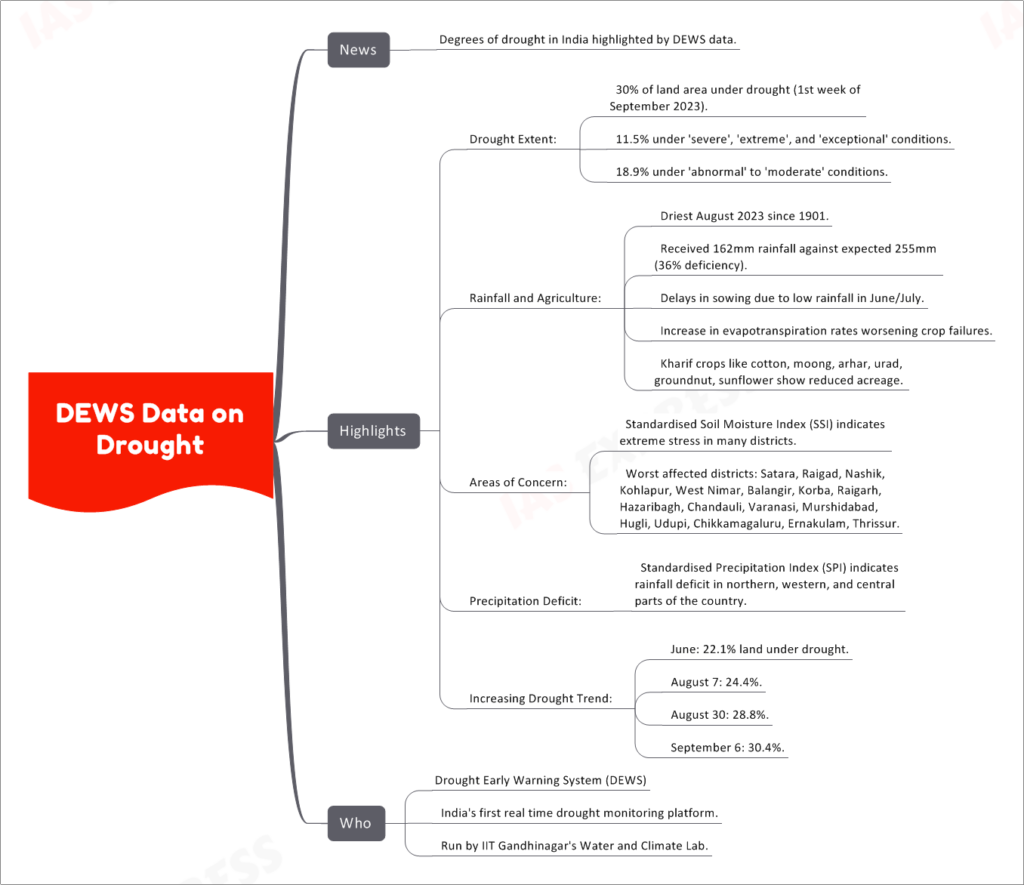[Newsbits] 11.09.2023

Global Biofuel Alliance
Global Biofuel Alliance Announced
What is the Global Biofuel Alliance (GBA)?
The Global Biofuel Alliance (GBA) is an India-led initiative aimed at boosting the production and use of biofuels as a sustainable alternative to fossil fuels such as petrol and diesel. The GBA is a collaborative effort to address global energy challenges, reduce greenhouse gas (GHG) emissions, and promote a cleaner and greener energy future.
Biofuel Definition (IEA)
Biofuels, as defined by the International Energy Agency (IEA), are liquid fuels derived from biomass, serving as alternatives to traditional fossil fuels like gasoline, diesel, and aviation fuels.
Types of Biofuels
- 1G (First Generation) Biofuels: These are produced from specific crops such as sugarcane, corn, and soybean.
- 2G (Second Generation) Biofuels: 2G biofuels are derived from sources like agricultural waste, used cooking oil, and animal residues. The GBA primarily focuses on 2G ethanol production.
Significance of the Global Biofuel Alliance
Global Crude Oil Situation
- Disruptions from Ukraine War: Recent geopolitical events, including the war in Ukraine, have led to disruptions in the global crude oil supply.
- Dependency on Imports: Many nations, including India (which imports 87% of its crude oil), are heavily dependent on oil imports, making them vulnerable to price fluctuations and supply disruptions.
Decarbonizing the Transport Sector
- Carbon Emissions from Transport: The transport sector contributes to approximately one-fourth of global carbon emissions.
- Rise of Electric Vehicles: While electric vehicles and battery production are on the rise, biofuels offer a viable solution for sectors that are challenging to decarbonize, such as aviation, shipping, and long-haul trucking.
Blending Biofuels
- Blending in India: India has already taken steps to blend biofuels, currently blending 10% and aiming to double this percentage in the near future.
Benefits of 2G Ethanol
- Reducing GHG Emissions: 2G ethanol can significantly reduce greenhouse gas emissions when compared to traditional fossil fuels.
- Extending Engine Life: It can extend the life of combustion engines while promoting sustainable practices.
- Boosting Farmers' Income: The production of biofuels can provide additional income opportunities for farmers and generate jobs.
How the Global Biofuel Alliance Works
GBA Goals
- International Collaboration: The GBA seeks to unite countries in collaborative efforts for the co-development of biofuels and related technologies.
- Technological Advancements: It aims to accelerate technological advancements in biofuel production to make the process more efficient and sustainable.
- Advocacy for Biofuels: The GBA advocates for the use of biofuels in the transport sector on a global scale.
Global Initiatives
- United States: The U.S. has amended its "Renewable Fuel Standard" to increase biofuel production, with the goal of substituting 140,000 barrels per day of crude oil imports by 2025.
- India: India has been actively pursuing biofuel initiatives since 2018, with plans to establish 12 new refineries for achieving 20% ethanol blending by 2025. These efforts align with India's broader goal of achieving net-zero emissions by 2070.
IEA Predictions
- The International Energy Agency predicts that India, along with Brazil and Indonesia, will account for two-thirds of the global demand for biofuels.
Who Are the Key Players in the Global Biofuel Alliance?
Founding Members
- India: Leading the initiative.
- United States: Actively participating in the alliance.
- Brazil: An important founding member.
Additional Members
- Argentina: A member of the G-20.
- Canada: A G-20 nation.
- Italy: Contributing to global biofuel efforts.
- South Africa: Representing the G-20 nations in the alliance.
India-Saudi Arabia Energy Sector MoU
MoU on Energy Sector Signed
What is the India-Saudi Arabia Energy Sector MoU?
The India-Saudi Arabia Energy Sector Memorandum of Understanding (MoU) signifies a significant agreement between the two nations to enhance cooperation in various aspects of the energy sector. It outlines areas of collaboration aimed at bolstering energy security, fostering renewable energy, and promoting sustainable development.
Highlights of the MoU
Cooperation Areas
The MoU encompasses a wide range of cooperation areas, including:
- Renewable Energy, Energy Efficiency, and Hydrogen: Both countries will collaborate on developing renewable energy sources, enhancing energy efficiency, and exploring the potential of hydrogen as a clean energy carrier.
- Electricity and Grid Interconnection: Efforts will be made to strengthen electricity infrastructure and grid interconnections.
- Petroleum, Natural Gas, and Strategic Petroleum Reserves: Cooperation will extend to petroleum and natural gas, including the strategic management of petroleum reserves to ensure energy security.
- Bilateral Investment: Encouragement of bilateral investment in areas such as renewable energy, electricity, hydrogen, energy storage, oil, and gas.
- Circular Economy Technologies: Focus on circular economy technologies, including carbon capture, utilization, and storage (CCUS).
- Digital Transformation: Collaboration on digital transformation initiatives in the energy sector, including innovations, cybersecurity, and artificial intelligence applications.
- Quality Partnerships: The MoU aims to foster quality partnerships that localize materials, products, and services for the energy sector, promoting robust supply chains and cutting-edge technologies.
- Strengthening Cooperation with Specialized Energy Companies: Efforts will be made to collaborate with specialized energy companies to advance mutual interests.
- Other Related Fields: Both countries are open to exploring additional areas of cooperation in the energy sector.
Significance of the Agreement
- IMEC Announcement Context: The MoU follows the announcement of the India-Middle East-Europe Economic Corridor (IMEC) by Prime Minister Narendra Modi during the 18th G20 Summit. Saudi Arabia is a founding partner of IMEC, and this agreement aligns with the broader economic corridor initiative.
- Global Energy Roles: India stands as the world's third-largest primary energy consumer, while Saudi Arabia ranks as the second-largest global crude oil producer. This agreement underscores their mutual interest in the energy sector.
Who are the Key Players?
- India: Represented by the Indian government.
- Saudi Arabia: Represented by the Saudi Arabian government.
Where was the MoU Signed?
- The MoU was signed at the first meeting of the India-Saudi Arabia Strategic Partnership Council.
Additional Facts
India's Targets and Initiatives
- Green Hydrogen Capacity: India has set a target of producing 5 million tonnes of green hydrogen annually.
- Renewable Energy Expansion: India aims to add an additional 125 GW of renewable energy capacity by 2030 under the National Green Hydrogen Mission, announced in August 2021.
- Global Biofuels Alliance: India has taken the lead in forming the Global Biofuels Alliance, focusing on recycling agriculture and forest residues, municipal solid waste (MSW), and cow dung into biofuels like ethanol and ammonia.
Saudi Arabia's Diversification Efforts
- Economic Diversification: Saudi Arabia, as the largest country in the Arabian Peninsula, is actively diversifying its economy away from oil dependence. The country is focusing on investments in sectors such as artificial intelligence (AI), blockchain, gaming, and tourism, as outlined in its Vision 2030 document.
The India-Saudi Arabia Energy Sector MoU represents a vital step towards fostering energy cooperation, promoting sustainable energy sources, and advancing economic diversification efforts in both nations. It is a significant development in the context of their global roles in the energy landscape.
G20 High Level Voluntary Principles on Hydrogen
- G20 Leaders Reach Agreement on Renewable Energy Targets
What are the G20 High-Level Voluntary Principles on Hydrogen?
The G20 High-Level Voluntary Principles on Hydrogen are guiding principles aimed at fostering international collaboration and cooperation in the development and utilization of hydrogen as a renewable energy source. These principles are a part of the G20 New Delhi Leaders Declaration, highlighting the commitment of G20 nations to promote sustainable and equitable hydrogen ecosystems.
Highlights of the Voluntary Principles
Collaboration Encouragement
- Development of National Standards: Encouraging the development of national standards for hydrogen production and utilization.
- Globally Harmonized Approach: Promoting a globally harmonized approach to hydrogen certification, particularly for hydrogen generated from zero and low emission technologies, as well as its derivatives like ammonia.
Trade Promotion
- Alignment with WTO Rules: Ensuring that the trade of hydrogen and its derivatives produced from zero and low emission technologies aligns with the rules of the World Trade Organization (WTO). This is supported by resilient and diversified supply chains.
Technological Acceleration
- Technological Innovation: Encouraging technological innovation in the hydrogen sector, including advancements in business models and collaborative research and development (R&D).
- Enhanced International Cooperation: Fostering international cooperation in research and development efforts related to hydrogen technologies.
Investment Promotion
- Investment Mobilization: Promoting the mobilization of investments to support the development of hydrogen infrastructure, production, utilization, and global trade of hydrogen and its derivatives from zero and low emission technologies.
- Finance Mobilization: Encouraging financial support for hydrogen-related projects and initiatives.
Information Sharing Support
- Voluntary Information Sharing: Encouraging the voluntary sharing of information among G20 nations regarding hydrogen production, utilization, and related technologies.
- Cooperation and Dialogue: Facilitating cooperation and dialogue among G20 countries to exchange knowledge and best practices in hydrogen development.
- Capacity Building: Supporting capacity building efforts in the field of hydrogen production, utilization, and derivatives from zero and low emission technologies.
Why the G20 High-Level Voluntary Principles on Hydrogen?
The Goal
The goal of these principles is to build a sustainable and equitable global hydrogen ecosystem that benefits all nations. By fostering international collaboration and setting guidelines for the development and utilization of hydrogen, G20 nations aim to contribute to net-zero greenhouse gas emissions and carbon-neutral pathways.
Additional Facts
- Green Hydrogen Innovation Centre: The G20 New Delhi Leaders Declaration makes mention of the Green Hydrogen Innovation Centre, which is steered by the International Solar Alliance. This center is likely to play a crucial role in advancing green hydrogen technologies.
The G20 High-Level Voluntary Principles on Hydrogen represent a significant step towards the global adoption of hydrogen as a clean and renewable energy source. By encouraging collaboration, trade, technological innovation, investment, and information sharing, these principles pave the way for a sustainable hydrogen future that contributes to a greener planet.
Shanti Swarup Bhatnagar Prize 2022
- SSB for Science and Technology, 2022
- Awarded to 12 Scientists
What is the Shanti Swarup Bhatnagar Prize?
The Shanti Swarup Bhatnagar Prize is an annual award that recognizes exceptional contributions in the fields of science and technology. It honors outstanding achievements in various scientific disciplines.
Highlights of the 2022 Awards
The 2022 Shanti Swarup Bhatnagar Prize celebrated the remarkable achievements of scientists across different fields:
Biofilm Research
- Understanding Biofilm-Induced Infections: Recognized for their research in comprehending biofilm-induced infections involving cellulose.
- Biofilms Defined: Biofilms are 3D structures formed by multiple microorganisms that adhere to surfaces.
- Recent Studies: Recent studies revealed that Mycobacterium tuberculosis can form biofilms, leading to drug-tolerant bacteria. Kumar's lab made a significant discovery by identifying cellulose as a key component holding mycobacterial cells together.
Phosphatase Studies
- Ascribing Functions to Phosphatases: Scientists were acknowledged for their work in understanding the roles of phosphatases in regulating cellular protein-sorting pathways.
- Phosphatases Defined: Phosphatases are enzymes that remove phosphate groups from proteins.
Heterocyclic and Carbocyclic Compounds
- Synthesis of Biologically Important Compounds: Researchers were awarded for their contributions to the synthesis of biologically important heterocyclic and carbocyclic compounds.
- Compound Classes Defined: These compounds belong to classes of organic compounds with applications in various biological fields, exhibiting activity against multiple illnesses.
Value-Added Materials
- Transforming Organic Molecules: Scientists were recognized for their research in developing value-added materials with applications in agrochemical and pharmaceutical industries.
Earth, Atmosphere, Ocean, and Planetary Sciences
- Role of Anthropogenic and Natural Factors: Research in understanding the influence of anthropogenic and natural factors on hydrological extremes and water resources in India was honored.
Seismic Design
- Mitigation of Seismic Effects: Contributions to the mitigation of seismic effects on buildings and bridges received recognition.
Methane Recovery Understanding
- From Marine Gas Hydrates: Scientists were awarded for their work on understanding methane recovery from marine gas hydrates.
- Marine Gas Hydrates Defined: These are ice-like substances housing vast methane gas reserves and are found on the seafloor and subsurface sediments at water depths of 300 meters and beyond.
Autoimmunity and Metaflammation
- Autoimmunity Defined: Autoimmunity refers to the immune system's attack on the body's cells and tissues.
- Metaflammation Defined: Metaflammation is characterized by chronic low-grade inflammation associated with obesity and induced by metabolism alterations.
Electric and Thermoelectrical Properties
- Of Strongly Interacting 2-D Atomically Thin Materials: Research on the electric and thermoelectrical properties of these materials was acknowledged.
- Atomically Thin Materials Defined: These materials have atomic-scale thicknesses, typically less than 5 nanometers, and are utilized in various batteries, including rechargeable metal-ion batteries, metal-sulfur batteries, and metal-air batteries.
Coherent Interactions of Neutrinos
- In Dense Astrophysical Environments: Scientists received recognition for their investigations into the nature of dark matter through coherent interactions of neutrinos.
Gender of Recipients
- All Male Recipients: In the 2022 awards, all recipients were male.
- Gender Disparity: Since its inception, the Shanti Swarup Bhatnagar Prize has seen only 19 women scientists among the recipients, highlighting the gender gap in scientific recognition.
Prize Details
- SSB Prizes Value: Each Shanti Swarup Bhatnagar Prize is valued at Rs 5,00,000.
- Award Frequency: The prizes are awarded annually.
- Awarded for: The awards recognize notable and outstanding research, whether applied or fundamental, in various disciplines of science and technology.
The Legacy of Shanti Swarup Bhatnagar
- Named After: The Shanti Swarup Bhatnagar Prize is named after Dr. Shanti Swarup Bhatnagar, the founder-director of the Council of Scientific and Industrial Research (CSIR).
Eligibility Criteria
- Eligibility: The awards are open to Indian citizens up to 45 years of age as of December 31st of the preceding year.
- Eligibility Extensions: Overseas citizens of India (OCI) and persons of Indian origin (PIO) working in India are also eligible for the awards.
Historical Background
- Inception: The Shanti Swarup Bhatnagar Prize was established in 1958.
- Last Announcement: The last announcement of awardees was made in 2021.
The Shanti Swarup Bhatnagar Prize continues to recognize and celebrate excellence in science and technology, encouraging innovative research and contributions to various scientific disciplines in India.
DEWS Data on Drought
Degrees of Drought in India Highlighted by DEWS Data
Highlights
Drought Extent
- 30% of Land Area Under Drought (1st Week of September 2023): The DEWS data reveals that a significant portion of India, approximately 30% of its land area, is currently experiencing drought conditions.
- Severity of Drought:
- 11.5% Under 'Severe', 'Extreme', and 'Exceptional' Conditions: A substantial portion of the affected land is facing severe to exceptional drought conditions.
- 18.9% Under 'Abnormal' to 'Moderate' Conditions: Additionally, nearly 19% of the affected areas are experiencing abnormal to moderate drought conditions.
Rainfall and Agriculture
- Driest August 2023 Since 1901: August 2023 witnessed the lowest rainfall levels in over a century.
- Rainfall Deficiency: The country received only 162mm of rainfall against the expected 255mm, marking a significant 36% rainfall deficiency.
- Sowing Delays: The low rainfall in June and July caused delays in sowing, affecting crop growth.
- Increase in Evapotranspiration Rates: The increased evapotranspiration rates further worsened crop failures.
- Impact on Kharif Crops: Key Kharif crops such as cotton, moong, arhar, urad, groundnut, and sunflower have shown reduced acreage due to adverse conditions.
Areas of Concern
- Standardised Soil Moisture Index (SSI): This index indicates extreme stress in many districts across the country.
- Worst Affected Districts: Several districts are facing the brunt of the drought, including Satara, Raigad, Nashik, Kohlapur, West Nimar, Balangir, Korba, Raigarh, Hazaribagh, Chandauli, Varanasi, Murshidabad, Hugli, Udupi, Chikkamagaluru, Ernakulam, and Thrissur.
Precipitation Deficit
- Standardised Precipitation Index (SPI): The SPI highlights significant rainfall deficits in the northern, western, and central parts of India.
Increasing Drought Trend
- June: In June, approximately 22.1% of the land was under drought conditions.
- August 7: By August 7, this figure had increased to 24.4%.
- August 30: On August 30, it further escalated to 28.8%.
- September 6: As of September 6, an alarming 30.4% of the land is grappling with drought.
Who is Behind DEWS?
- Drought Early Warning System (DEWS): DEWS is India's first real-time drought-monitoring platform.
- Operated by IIT Gandhinagar's Water and Climate Lab: This vital system is run by the Water and Climate Lab at the Indian Institute of Technology (IIT) Gandhinagar.
The DEWS data serves as a critical tool for monitoring and addressing drought conditions in India. As the extent of drought continues to grow, it underscores the urgent need for effective water resource management, agricultural strategies, and measures to mitigate the impact on vulnerable communities.
If you like this post, please share your feedback in the comments section below so that we will upload more posts like this.





